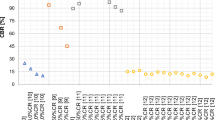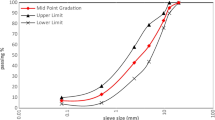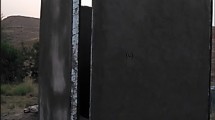Abstract
This study focuses on optimizing process parameters to minimize the thickness of Ru–San composite blocks against high-velocity impact, aiming to enhance projectile energy absorption, particularly in military trench systems. The critical challenge in developing composite blocks as potential sandbag replacements for trench-bunker systems is optimizing their thickness for improved energy absorption during high-velocity impacts. By employing an optimization technique, this study seeks to determine the minimum thickness of the rubber–sand composite block capable of withstanding the full kinetic energy of a projectile without piercing, thereby advancing protective measures in military and security applications. The material used is a rubber–sand composite, consisting of 00 to 20 wt% of sand particles with various sizes ranging from 250 to 750 μm. The optimisation approach employed in this study includes screening design, Vikor and analytic hierarchy process of optimisation techniques. Finite element simulation is used to model the projectile's impact on the rubber–sand composite block and to analyse the energy absorption behaviour of the material under high-velocity impact. The results of this study show that process parameters such as the thickness of the target, wt% of sand, and size of sand particles significantly impact the energy absorption of the rubber–sand composite block. The optimised parameters are determined to be a thickness of 40 mm, 20 wt% of sand, and sand sizes of 750 μm. The findings of this study have important implications for the design and development of materials that can effectively withstand high-velocity impact, particularly in the field of military defence.













Similar content being viewed by others
Data and code availability
No data, models, or code were generated or used during the study.
References
Anbazhagan P, Manohar DR (2015) Energy absorption capacity and shear strength characteristics of waste tire crumbs and sand mixtures. Int J Geotech Earthq Eng 6:28–49. https://doi.org/10.4018/IJGEE.2015010103
Antony J (2014) Screening designs. In: Antony J (ed) Design of experiments for engineers and scientists, 2nd edn. Elsevier, Amsterdam, pp 51–62
Bhanwar P, Reddy AS, Dave TN (2023) A spreadsheet-based decision support system for selection of optimal soil liquefaction mitigation technique. Decis Anal J 6:100154. https://doi.org/10.1016/j.dajour.2022.100154
Chen Q, Shi Q, Gorb SN, Li Z (2014) A multiscale study on the structural and mechanical properties of the luffa sponge from Luffa cylindrica plant. J Biomech 47:1332–1339. https://doi.org/10.1016/j.jbiomech.2014.02.010
de Rosaria FSM, Russo RC (2015) Criteria in AHP: a systematic review of literature. Proc Comput Sci 55:1123–1132. https://doi.org/10.1016/j.procs.2015.07.081
Doddamani S, Kulkarni SM, Joladarashi S, Mohan Kumar TS, Gurjar AK (2023) Analysis of light weight natural fiber composites against ballistic impact: a review. Int J Light Mater Manuf 6:450–468
Doddamani S, Kulkarni SM, Joladarashi S, Gurjar AK, Kumar TSM (2024) Development of rubber–sand composite for enhanced impact resistance: implications of vulcanization. Eng Sci Technol an Int J 51:101631. https://doi.org/10.1016/j.jestch.2024.101631
Duffy M (2009) Sandbags. https://www.firstworldwar.com/atoz/sandbags.htm
Ge Q, Zuo W, Liu R, Zhu B, Zhao P, Wan L, Wang Y, Zhao R (2022) Experimental studies for shear and multi-impact resistance performance of sand–geofoam material. Buildings 12:633. https://doi.org/10.3390/buildings12050633
Ginting EM, Bukit N, Muliani FE (2017) Mechanical properties and mophology natural rubber blend with bentonit and carbon black. IOP Conf Ser Mater Sci Eng 223:4–11. https://doi.org/10.1088/1757-899X/223/1/012003
Gurjar AK, Kulkarni SM, Joladarashi S, Doddamani S (2024) Investigation of mechanical properties of luffa fibre reinforced natural rubber composites: implications of process parameters. J Mater Res Technol 29:4232–4244. https://doi.org/10.1016/j.jmrt.2024.02.133
Haris A, Tan VBC (2020) Experimental study on compaction effects on the ballistic resistance of sandbags. Int J Impact Eng 142:103609. https://doi.org/10.1016/j.ijimpeng.2020.103609
Keerthan Kumar TG, Addya SK, Satpathy A, Koolagudi SG (2023a) NORD: NOde Ranking-based efficient virtual network embedding over single Domain substrate networks. Comput Networks 225:109661. https://doi.org/10.1016/j.comnet.2023.109661
Keerthan Kumar TG, Srivastava A, Satpathy A, Addya SK, Koolagudi SG (2023b) MatchVNE: a stable virtual network embedding strategy based on matching theory. In: 2023 15th International Conference on COMmunication Systems & NETworkS (COMSNETS), Bangalore, India, pp 355–359
Khoshabi P, Nejati E, Ahmadi SF et al (2020) Developing a multi-criteria decision making approach to compare types of classroom furniture considering mismatches for anthropometric measures of university students. PLoS ONE 15:1–25. https://doi.org/10.1371/journal.pone.0239297
Kumar R, Singh S, Bilga PS, Singh J, Singh S, Scutaru M-L, Pruncu CI (2021) Revealing the benefits of entropy weights method for multi-objective optimization in machining operations: a critical review. J Mater Res Technol 10:1471–1492. https://doi.org/10.1016/j.jmrt.2020.12.114
Leibenluft J (2008) Sandbag. https://en.wikipedia.org/wiki/Sandbag. Accessed 8 May 2022
Li K, Yan S, Zhong Y, Pan W, Zhao G (2019) Multi-objective optimization of the fiber-reinforced composite injection molding process using Taguchi method, RSM, and NSGA-II. Simul Model Pract Theory 91:69–82. https://doi.org/10.1016/j.simpat.2018.09.003
Liu Y, Wang HK, Zhang X (2013) A multiscale framework for high-velocity impact process with combined material point method and molecular dynamics. Int J Mech Mater Des 9:127–139. https://doi.org/10.1007/s10999-013-9213-2
Mahesh V, Joladarashi S, Kulkarni SM (2021a) Development and mechanical characterization of novel polymer-based flexible composite and optimization of stacking sequences using VIKOR and PSI techniques. J Thermoplast Compos Mater 34:1080–1102. https://doi.org/10.1177/0892705719864619
Mahesh V, Joladarashi S, Kulkarni SM (2021b) Comparative study on ballistic impact response of neat fabric, compliant, hybrid compliant and stiff composite. Thin-Walled Struct 165:107986. https://doi.org/10.1016/j.tws.2021.107986
Manohar DR, Anbazhagan P (2021) Shear strength characteristics of geosynthetic reinforced rubber–sand mixtures. Geotext Geomembr 49:910–920. https://doi.org/10.1016/j.geotexmem.2020.12.015
Marr J, Zartmann L, Reinel-Bitzer D, Andrä H, Müller R (2023) Multiscale optimization of the viscoelastic behavior of short fiber reinforced composites. Int J Mech Mater Des 19:501–519. https://doi.org/10.1007/s10999-023-09645-w
Mohan Kumar TS, Joladarashi S, Kulkarni SM, Doddamani S (2022) Optimization of process parameters for ballistic impact response of hybrid sandwich composites. Int J Interact Des Manuf. https://doi.org/10.1007/s12008-022-01061-2
Mohan Kumar TS, Joladarashi S, Kulkarni SM, Doddamani S (2023) Experimental and numerical investigation on low-velocity impact response of sandwich structure with functionally graded core. Polym Compos. https://doi.org/10.1002/pc.27986
Nurmuslimah S, Saidatin N (2021) Application of vikor (vise kriterijumska optimizacija i kompromisno resenje) method for identifying amplifier damage. IOP Conf Ser Mater Sci Eng 1010:01204. https://doi.org/10.1088/1757-899X/1010/1/012024
Prasad VBSR, VenkataRao G, Idrees M (2020) Identification of Damping Characteristics of EPDM-RUBBER with applications to sandwiched beams and considerations to Engine Mounts for Performance Evaluation. Mater Today Proc 24:628–640. https://doi.org/10.1016/J.MATPR.2020.04.317
Qiao P, Yang M, Bobaru F (2008) Impact mechanics and high-energy absorbing materials: review. J Aerosp Eng 21:235–248
Raheja S, Obaidat MS, Kumar M, Sadoun B, Bhushan S (2022) A hybrid MCDM framework and simulation analysis for the assessment of worst polluted cities. Simul Model Pract Theory 118:102540. https://doi.org/10.1016/j.simpat.2022.102540
Rajole S, Ravishankar KS, Kulkarni SM (2020) Performance study of jute-epoxy composites/sandwiches under normal ballistic impact. Def Technol 16:947–955. https://doi.org/10.1016/j.dt.2019.11.011
Ruan C, Ouyang J, Liu S (2012) Multi-scale modeling and simulation of crystallization during cooling in short fiber reinforced composites. Int J Heat Mass Transf 55:1911–1921. https://doi.org/10.1016/j.ijheatmasstransfer.2011.11.046
Saaty RW (1987) The analytic hierarchy process—what it is and how it is used. Math Model 9:161–176. https://doi.org/10.1016/0270-0255(87)90473-8
Sangamesh R (2019) Development of sandwich composites from natural materials for bullet proofing. National Institute of Technology Karnataka, Surathkal
Sarajpoor S, Kavand A, Zogh P, Ghalandarzadeh A (2020) Dynamic behavior of sand-rubber mixtures based on hollow cylinder tests. Constr Build Mater 251:118948. https://doi.org/10.1016/j.conbuildmat.2020.118948
Shaik A, Salvi A (2017) A multi scale approach for analysis of fiber reinforced composites. Mater Today Proc 4:3197–3206
Sun X, Gao Z, Cao PZC (2019) Mechanical properties tests and multiscale numerical simulations for basalt fiber reinforced concrete. Constr Build Mater 202:58–72
Suniantara IKP, Putra IGEW (2019) Comparison of VIKOR and TOPSIS methods in multiresponse Taguchi optimization. J Educ Res Eval 2:106. https://doi.org/10.23887/jere.v2i3.12796
Thawani B, Hazael R, Critchley R (2021) Numerical modelling study of a modified sandbag system for ballistic protection. J Comput Sci 53:101403. https://doi.org/10.1016/j.jocs.2021.101403
Vishwas M, Joladarashi S, Kulkarni SM (2019) Investigation on the eect of using rubber as core material in sandwich composite plate subjected to low-velocity normal and oblique impact loadings. Sci Iran 26:897–907. https://doi.org/10.24200/sci.2018.5538.1331
Wang J, Chu X (2019) Impact energy distribution and wavefront shape in granular material assemblies. Granul Matter 21:23. https://doi.org/10.1007/s10035-019-0880-z
Zhao Z, Dang H, Zhang C, Yun GJ, Li Y (2018) A multi-scale modeling framework for impact damage simulation of triaxially braided composites. Compos Part A Appl Sci Manuf 110:113–125. https://doi.org/10.1016/j.compositesa.2018.04.020
Funding
This research received no specific grant from any funding agency in the public, commercial, or not-for-profit sectors.
Author information
Authors and Affiliations
Contributions
Saleemsab Doddamani—writing—original draft, writing—review and editing; Satyabodh M. Kulkarni—conceptualization, methodology, supervision; Sharnappa Joladarashi—review, modifications; Ashish Kumar Gurjar—Information collection, resources, modifications; Mohan Kumar T S—Information collection, modifications, validation.
Corresponding author
Ethics declarations
Conflict of interest
The authors declare that they have no conflict of interest.
Additional information
Publisher's Note
Springer Nature remains neutral with regard to jurisdictional claims in published maps and institutional affiliations.
Rights and permissions
Springer Nature or its licensor (e.g. a society or other partner) holds exclusive rights to this article under a publishing agreement with the author(s) or other rightsholder(s); author self-archiving of the accepted manuscript version of this article is solely governed by the terms of such publishing agreement and applicable law.
About this article
Cite this article
Doddamani, S., Kulkarni, S.M., Joladarashi, S. et al. Enhancing energy absorption in rubber–sand (Ru–San) composite blocks against ballistic impact: a multi-objective optimisation approach. Multiscale and Multidiscip. Model. Exp. and Des. (2024). https://doi.org/10.1007/s41939-024-00466-8
Received:
Accepted:
Published:
DOI: https://doi.org/10.1007/s41939-024-00466-8




